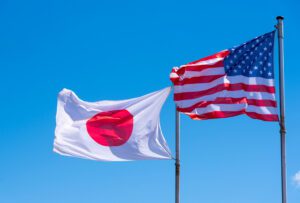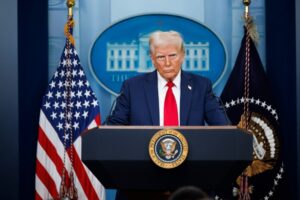Executive Order Further Modifying the Reciprocal Tariff Rates
On July 31, the White House announced a new Executive Order “Further Modifying the Reciprocal Tariff Rates.” A copy of the order, including country-by-country tariff rates, can be found here.
07/31/2025 | The White House
WITA’s Friday Exchange Podcast:
Former Trade Negotiators Unpack this Week’s Trade & Tariff Announcements
Former Trade Negotiators Discuss This Week’s Tariff and Trade Developments with the EU.
No one understands the dynamics with key U.S. trading partners better than the people who led these kind of difficult trade negotiations for the United States. Panelists will update our subscribers on the tariff and trade announcements, what remains undone; and what are expected next steps in these negotiations.
Featured Speakers:
Introduction: Kenneth Levinson, CEO, Washington International Trade Association
Daniel Mullaney, Non-Resident Senior Fellow, Atlantic Council; former Assistant U.S. Trade Representative for Europe and the Middle East, Office of the U.S. Trade Representative
John Clarke, Former Director International Affairs European Commission, European Union
Moderator: Penny Naas, Lead GMF Allied Strategic Competitiveness, German Marshall Fund of the United States
Watch the Video on YouTube | Listen on Spotify or Apple Podcasts
07/31/2025 | WITA
“The Largest Trade Deal in History”: Implications of the US-Japan Trade Deal
WITA Editors note: The trade deal between the US and Japan was announced before the deal between the U.S. and EU, which then became the “biggest deal of them all.” Following is an excerpt.
…The new US-Japan trade deal also has implications for each nation’s broader international engagement.
First, the trade agreement raises questions about the future of the United States–Mexico–Canada Agreement (USMCA), which is up for renegotiation or renewal in 2026. Amid tariff negotiations, Trump administration officials have said little about USMCA other than that they intend to renegotiate it. But the administration has been aggressive in its negotiations with Mexico and Canada, placing a 25 percent tariff on both countries and demanding that they do more to combat fentanyl trafficking. That translates to a 25 percent tariff on Canadian and Mexican goods that are not compliant with USMCA rules of origin. USMCA-compliant automobiles and auto parts from Canada and Mexico are subject to a 25 percent tariff. Noncompliant goods are assessed a rate of 52.5 percent.
Those figures become significant in the context of the new US-Japan trade deal. Automotive imports from Japan have a lower tariff rate (15 percent) than automotive goods from Canada or Mexico (25 percent). This affects American automakers, such as General Motors, Ford, and Stellantis, that depend on Canada and Mexico for their automotive supply chains and assembly lines. But it also harms Japanese automakers. Honda, Nissan, and Toyota also depend on Canada and Mexico for their products. Moreover, US firms fear that the 50 percent Section 232 tariffs on steel and aluminum will further increase their domestic production costs while Japanese auto companies pay a lower rate on their imports. The American Automotive Policy Council, which consists of GM, Ford, and Stellantis, criticized the trade deal as harmful to North American–built vehicles. The administration’s handling of these concerns may indicate how it will approach USMCA renegotiations in 2026.
The US-Japan trade deal also provides a model for US deals with the EU and South Korea. Like Japan, these entities are major US trading partners with significant trade surpluses. Reports indicate that Brussels is on track to agree to 15 percent reciprocal tariffs and automotive tariffs. South Korean government and industry officials are also aiming to secure a 15 percent tariff in exchange for a similar industrial investment fund and increased market access for US corn products. Given the number of states hoping to lock down deals before the White House’s August 1 deadline, the US could benefit from having the EU and South Korea follow the Japanese template.
Read the Full Policy Memo Here
07/25/2025 | William Chou | Hudson Institute
An Alliance For Open Trade: How To Counter Trump’s Tariffs
The US administration’s latest threat to impose sweeping new tariffs on many of its closest allies signals a renewed embrace of aggressive unilateralism and misunderstood economics. This column argues that the only effective response is a coordinated one. Unified retaliation by a coalition of like-minded countries made up of the EU, Canada, Mexico, Brazil, and South Korea – which together account for more than 50% of all US goods exports – would be impossible for Washington to ignore and would send a powerful message that the rules-based global trading system is worth defending.
The White House revived its favourite economic weapon last week, threatening to impose sweeping new tariffs on many of the US’ closest allies. The proposed duties – 30% on goods from the EU and Mexico, 35% on those from Canada, 50% on imports from Brazil – signal a renewed embrace of aggressive unilateralism and misunderstood economics. The move follows a tense trade skirmish with China in April that saw tariffs spike to an unprecedented 145% before a fragile truce was reached – a truce set to expire in mid-August. Disturbingly, and unlike in President Trump’s first administration, the US now is not even attempting to justify its violations of WTO rules or its own free trade agreements. Thus, the world is now on notice: the main architect of the postwar global economic order seems intent on dismantling it.
For leaders in capitals from Brussels to Seoul, this presents a daunting challenge. The impulse to de-escalate, or for each capital to seek its own separate accommodation with Washington, is strong. But appeasement or fragmented, go-it-alone retaliation would be a strategic error. Such actions would only embolden further protectionism and accelerate the erosion of the rules-based system. The only effective response is a coordinated one. The US’ allies must form a united front, demonstrating that the principles of free and fair trade are not theirs to abandon.
07/27/2025 | Julian Hinz, Moritz Schularick, Keith Head, Isabelle Mejean & Emanuel Ornelas | Center for Economic Policy Research
A Progressive Industrial Policy for the Global South: A Latin American Perspective
The Global South must redefine industrial policy to build new productive capabilities and address escalating global challenges.
The global economy is undergoing a profound transformation, moving away from the neoliberal globalisation that defined international economic relations from the 1980s until the 2008 financial crisis. This shift is driven by the climate emergency, the digital revolution, rising military tensions, and an escalating trade war involving the United States, the European Union, and China. This conflict extends beyond tariffs, encompassing the race for critical minerals, control of digital platforms, the restructuring of global value chains, and the appropriation of intellectual property.
This structural conflict has had two major consequences. First, the neoliberal multilateral trade order has been effectively surpassed. Unilateral measures, such as tariffs, investment restrictions, and selective subsidies, have displaced foundational World Trade Organisation (WTO) principles like “Most-favoured-nation” (MFN) and “National Treatment”. New logics, based on national security, strategic autonomy, and geopolitical competition, have taken precedence. Second, the use of industrial policy (IP) instruments, including tariffs, investment regulations, subsidies, and public spending, has become normalised as a legitimate means to strengthen domestic strategic sectors and reconfigure national comparative advantages.
07/28/2025 | José Miguel Ahumada & Fernando Sossdorf | Social Europe
Tariffs, Trade Tensions and Climate Policy: The New Frontier of Green Trade Measures
Global trade is undergoing a profound transformation. As climate change becomes one of the most pressing challenges of our time, governments are increasingly linking environmental goals with trade policy. This shift is introducing a new set of dynamics tariffs, trade tensions, and climate policy that together shape what many are calling the new frontier of green trade measures.
While trade policy has historically focused on economic interests such as protecting local industries or balancing trade deficits, it is now being leveraged to drive environmental change. The result is a more complex and sometimes controversial global trade landscape.
The Rise of Climate-Linked Trade Measures
In recent years, countries have begun to incorporate climate goals into their trade frameworks. One of the most prominent developments is the emergence of carbon border adjustment mechanisms policies that place tariffs or fees on imported goods based on their carbon emissions. These measures are designed to prevent “carbon leakage,” where companies move production to countries with looser climate regulations to avoid environmental costs.
The European Union’s Carbon Border Adjustment Mechanism (CBAM), for example, aims to level the playing field by applying carbon pricing to imported goods such as steel, aluminum, and cement. The idea is to ensure that domestic industries that follow strict environmental standards are not undercut by cheaper, more polluting imports.
07/26/2025 | Radhika Kalas | Global Trade
WITA – We put the community in trade community.
Information about upcoming WITA and trade community events







